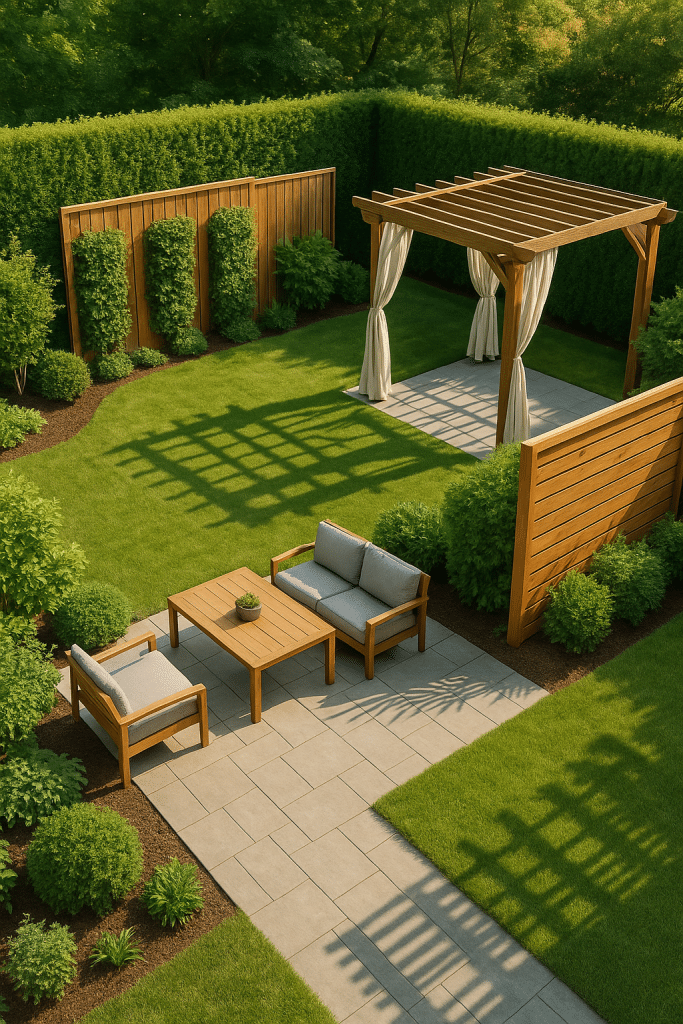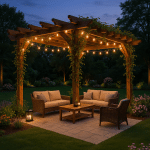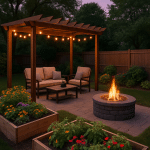Introduction to Backyard Privacy: Why It Matters for Homeowners
If you’re like many homeowners, your backyard is more than just open space — it’s an extension of your home, a personal sanctuary where family memories are made, and relaxation happens. Yet, without adequate privacy, it can feel less like your own retreat and more like a showcase for neighbors or passersby. That’s why backyard privacy ideas aren’t just a luxury; they’re a necessity for anyone looking to create a comfortable, secure, and inviting outdoor living environment. In this comprehensive guide, I’ll share six creative backyard privacy ideas that combine practicality, style, and sustainability so your outdoor space feels truly yours.
From integrating lush greenery that offers natural seclusion to building pergolas that blend both shade and privacy, each idea is tailored to help you tackle common issues like noise reduction, urban living constraints, and environmental sustainability. We’ll even explore how to transform small or rented properties with affordable, easy-to-implement solutions. So, whether you’re aiming for full enclosure or subtle privacy barriers, this article will equip you with the knowledge to revamp your backyard while enhancing its utility and charm.
Incorporating Lush Greenery for Natural Seclusion
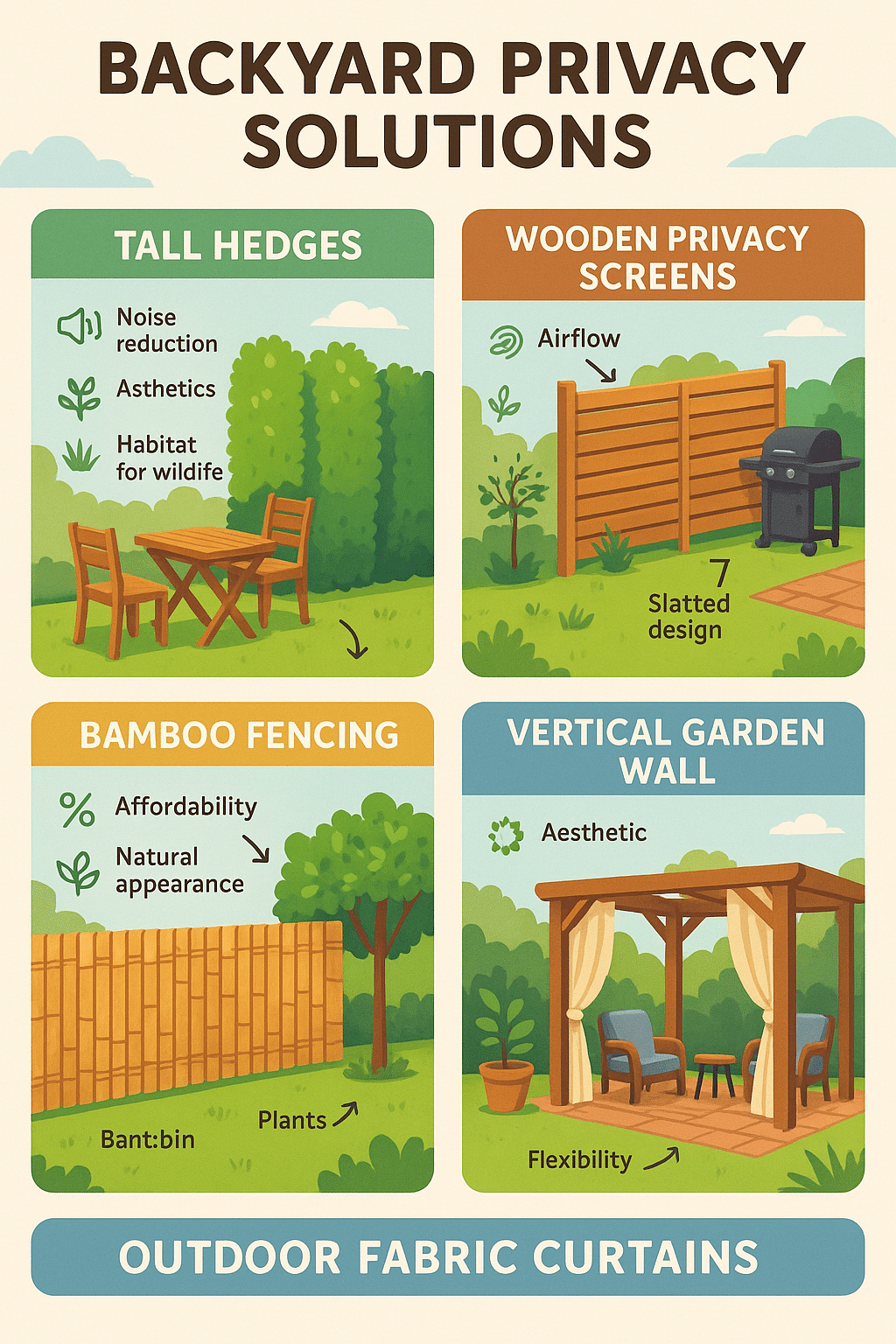
One of the most timeless and effective backyard privacy ideas involves leveraging nature itself. Lush greenery isn’t just visually appealing — it serves as a living barrier that can soften noise, block unsightly views, and contribute to a healthier outdoor environment.
Selecting Tall Hedge Plants and Evergreen Trees for Year-Round Privacy
When envisioning natural privacy screens, tall hedge plants and evergreen trees are the stars of the show. Species like Leyland Cypress, Arborvitae, and Boxwood grow densely and tall, providing a year-round green wall that blocks visibility from neighboring properties.
For example, Leyland Cypress is favored for its fast growth rate, reaching up to 3 feet annually, which means you can establish a privacy hedge within a couple of growing seasons. This evergreen offers a lush, dense screen that’s excellent for noise buffering as well.
Boxwood hedges, while slower-growing, excel in formal landscaping due to their tightly packed foliage. If you prefer adding texture and dimension, Southern Magnolia trees come with large, glossy leaves that offer privacy while contributing fragrant blooms in warmer months.
When planting these, consider a staggered layout to reduce gaps and enhance fullness. Make sure to prepare your soil properly—adding organic compost and maintaining consistent watering will promote healthy growth. Furthermore, pruning annually ensures your green privacy barrier stays manicured without losing its density.
Using Native Plant Species to Enhance Sustainability and Privacy
Beyond visual appeal, choosing native plants offers ecological advantages. Native species are adapted to your local climate and soil, which means they usually require less water, fertilizer, and pesticides, reducing long-term maintenance.
For example, Eastern Red Cedar in many U.S. regions is a native evergreen that provides excellent vertical growth, making it perfect for privacy while supporting local wildlife like birds and pollinators. Similarly, native bamboo varieties suitable for your zone grow quickly and form dense screens but keep in mind that some types can be invasive, so opt for clumping bamboo over running types.
By investing in native plants, you create a backyard ecosystem that’s healthier and more resilient. These natural backyard privacy barriers not only protect your space but also contribute to sustainability — an increasingly important consideration in current landscaping practices.
Building and Utilizing Pergola Structures for Stylish Privacy
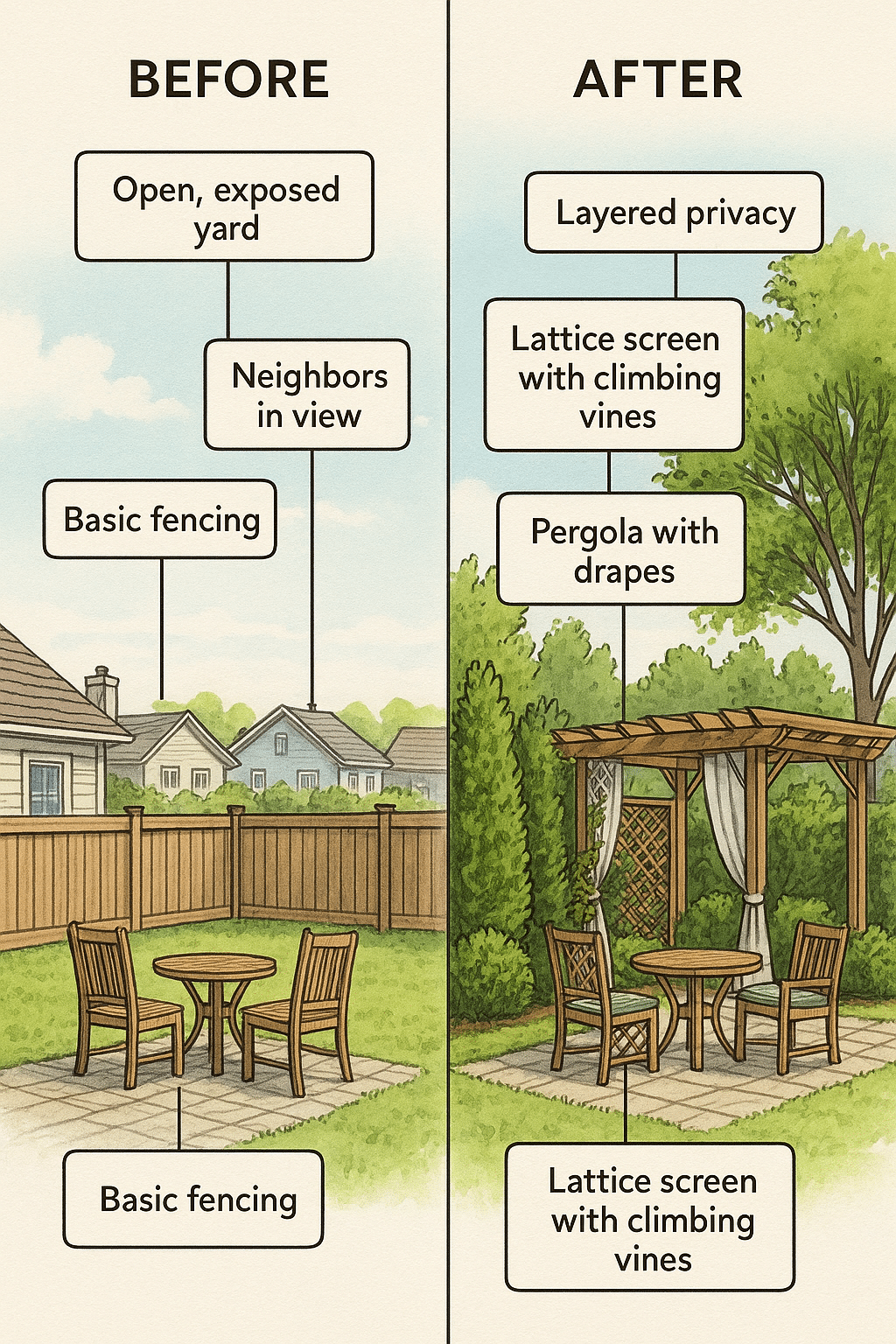
Pergolas have long been beloved for adding architectural interest and shade. But here’s the thing: they can also be masterful tools in your toolkit for backyard privacy ideas. A well-designed pergola offers a semi-enclosed retreat with a distinct feeling of shelter.
Supporting Climbing Vines like Ivy and Jasmine on Pergolas
One popular tactic involves growing climbing vines such as English ivy, Star Jasmine, or Clematis across your pergola framework. These vines thrive on vertical surfaces, transforming bare beams into lush curtains of greenery and flowers. For instance, Star Jasmine adds not only a privacy screen but also emits a wonderful fragrance during blooming season.
Supporting climbing vines requires some patience and preparation:
- Start with sturdy pergola beams spaced appropriately for vine attachment.
- Train young vines using soft garden ties or trellis wires to encourage upward growth.
- Consider vine varieties suited to your climate and pergola material.
- Regularly prune vines to prevent overgrowth and maintain an airy yet dense barrier.
The beauty of this approach lies in its dynamic nature. Depending on the vine variety and growth stage, your pergola can become more opaque or slightly see-through, giving you flexibility on how much privacy you want at different times.
Installing Outdoor Curtains on Pergolas for Flexible Enclosures
If you’re drawn to the idea of pergolas but want the option to alter your level of privacy day to day, outdoor curtains are your best friend. Made with weather-resistant fabrics, these curtains can be mounted along the edges of your pergola and pulled closed when you need seclusion or drawn back to enjoy an open view.
Here are some tips on choosing and installing outdoor curtains on pergolas:
- Material: Opt for UV-resistant, waterproof fabrics like solution-dyed acrylic to prevent fading and mold.
- Hardware: Use stainless steel or aluminum curtain rods that can handle weather fluctuations.
- Style: Choose neutral colors for a classic look or bold patterns for a statement piece.
- DIY-friendly: Installing curtains is often a straightforward weekend project requiring just a drill, screw anchors, and curtain rings.
This flexible setup works beautifully for creating cozy outdoor seating areas ideal for dining, entertaining, or quiet relaxation, all while keeping unwanted eyes at bay.
Creating Vertical Gardens and Living Walls for Eco-Friendly Barriers
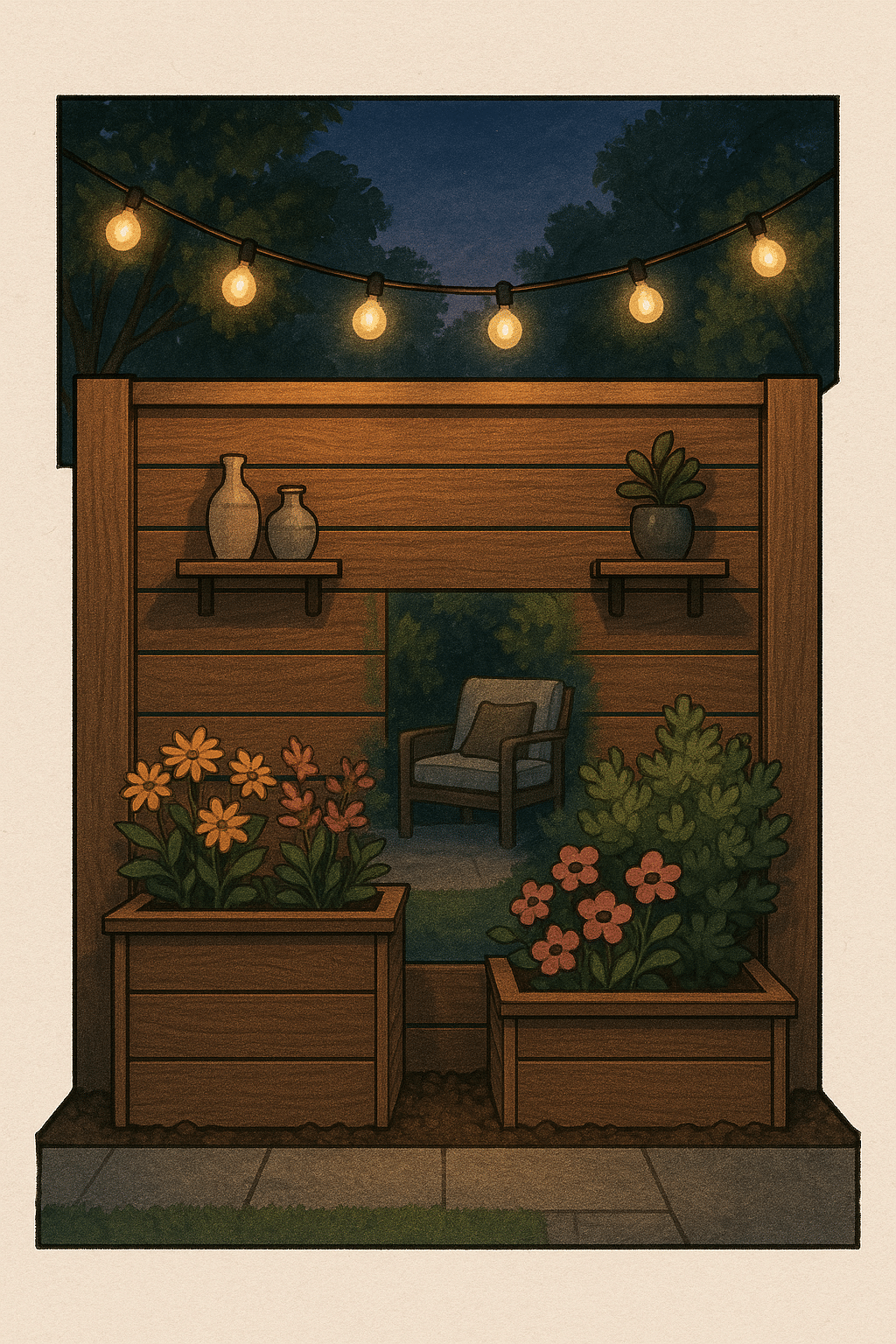
Vertical gardens and living walls are innovative, space-saving ways to achieve privacy, especially in smaller yards or urban settings where ground space is limited.
Container Gardening Techniques for Vertical Spaces
Container gardens can be arranged on trellises, stacked shelves, or specially designed vertical planters. Popular container plants include ferns, herbs, and flowering plants such as petunias and pansies, which add color and texture.
Container vertical gardening involves:
- Selecting lightweight containers to avoid structural strain.
- Ensuring proper drainage to prevent waterlogging and root rot.
- Arranging containers in a manner that maximizes coverage and reduces sightlines.
- Integrating drip irrigation or self-watering planters for ease of maintenance.
For example, a layered canvas pocket planter filled with a variety of herbs and cascading flowers can turn a bland wall into a vibrant, fragrant privacy screen.
Using Succulents and Moss in Vertical Gardening
Succulents, with their unique shapes and drought tolerance, offer stunning visual interest and low-maintenance appeal. Moss walls, on the other hand, bring a soft, lush backdrop that works well in shady areas. Both are fantastic options for creating eco-friendly backyard privacy solutions.
To create a succulent or moss living wall:
- Use a waterproof frame lined with soil or moss substrate.
- Plant succulents with varying leaf sizes and colors to create texture.
- Position moss walls in shaded or semi-shaded areas to maintain moisture.
- Consider adding a water mist system if irrigation is sparse.
Many homeowners report that vertical gardens like these not only boost privacy but also improve air quality and outdoor ambience, making their backyards into tranquil retreats.
Using Freestanding and Modern Privacy Screens as Focal Points
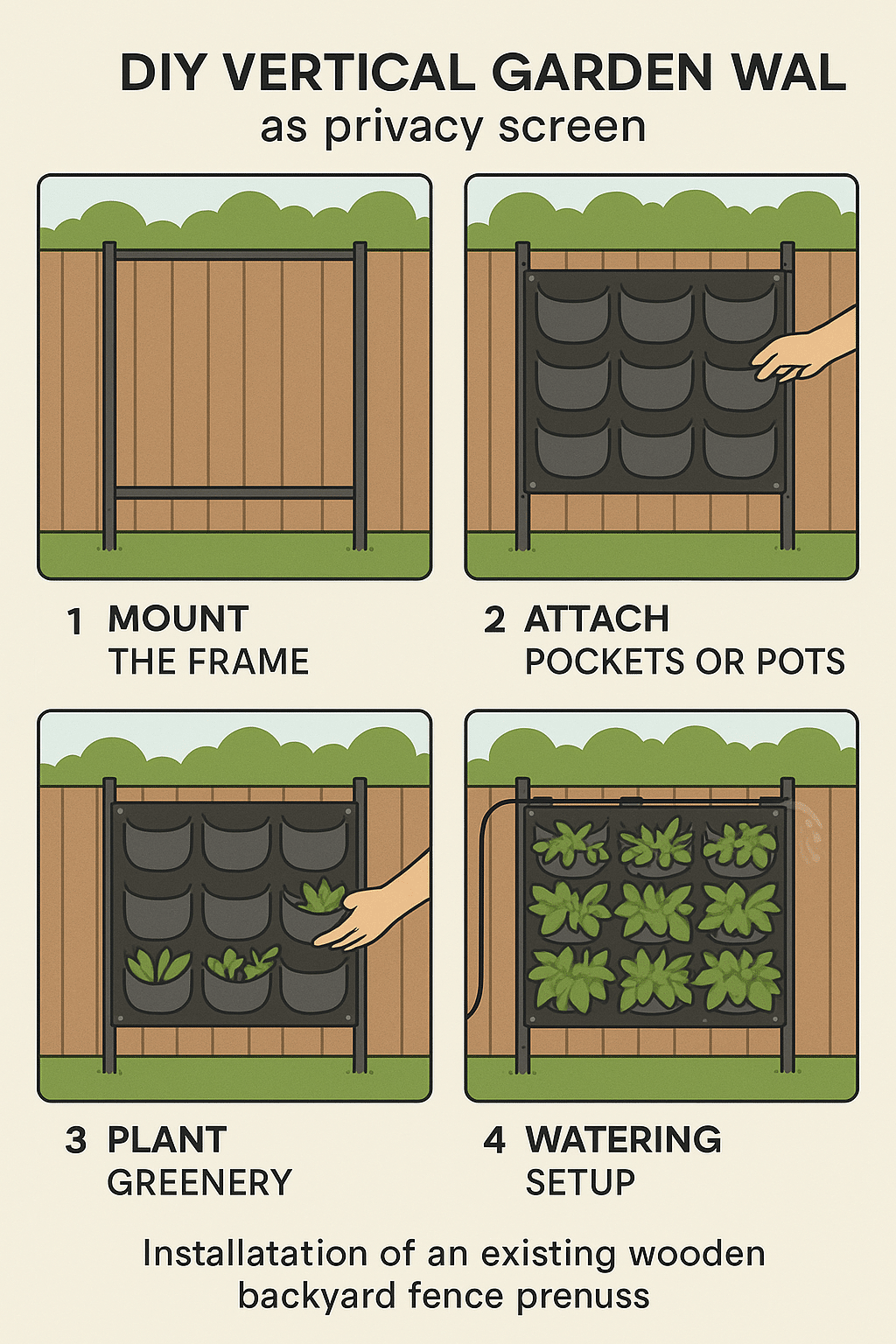
Freestanding privacy screens have surged in popularity as homeowners seek stylish alternatives to traditional fencing. These structures are easy to install, often portable, and can double as decorative elements.
Materials and Designs for Contemporary Backyard Privacy Screens
Modern privacy screens come in a variety of materials including:
- Metal: Laser-cut aluminum or steel screens offer durability and intricate patterns that blend function with art.
- Wood: Cedar or redwood panels provide warmth and can be stained or painted to complement your home’s exterior.
- Composite: Synthetic wood looks natural but requires less upkeep and resists weathering.
Design trends favor geometric patterns, nature-inspired cutouts, and color-blocked panels. For example, a laser-cut metal screen with a leaf motif can create filtered sunlight effects while blocking neighbors’ views.
When selecting a material, consider factors like wind resistance, maintenance, and whether you want the screen as a permanent feature or something that can move seasonally.
DIY Backyard Privacy Screens: Affordable and Personalized Options
If you’re keen on budgeting but don’t want to sacrifice style, DIY privacy screens are perfect. Using pallets, lattice panels, or reclaimed wood can create charming, personalized screens with a variety of finishes.
A simple DIY project might involve:
- Sanding and sealing old pallets.
- Connecting multiple pallets vertically for a tall barrier.
- Adding hooks or shelves to hold potted plants or lights.
- Painting or staining to enhance aesthetics.
Many DIY enthusiasts combine screens with climbing vines or fairy lights to create intimate garden nooks on a shoestring.
Adding Water Features for Soundproofing and Ambiance
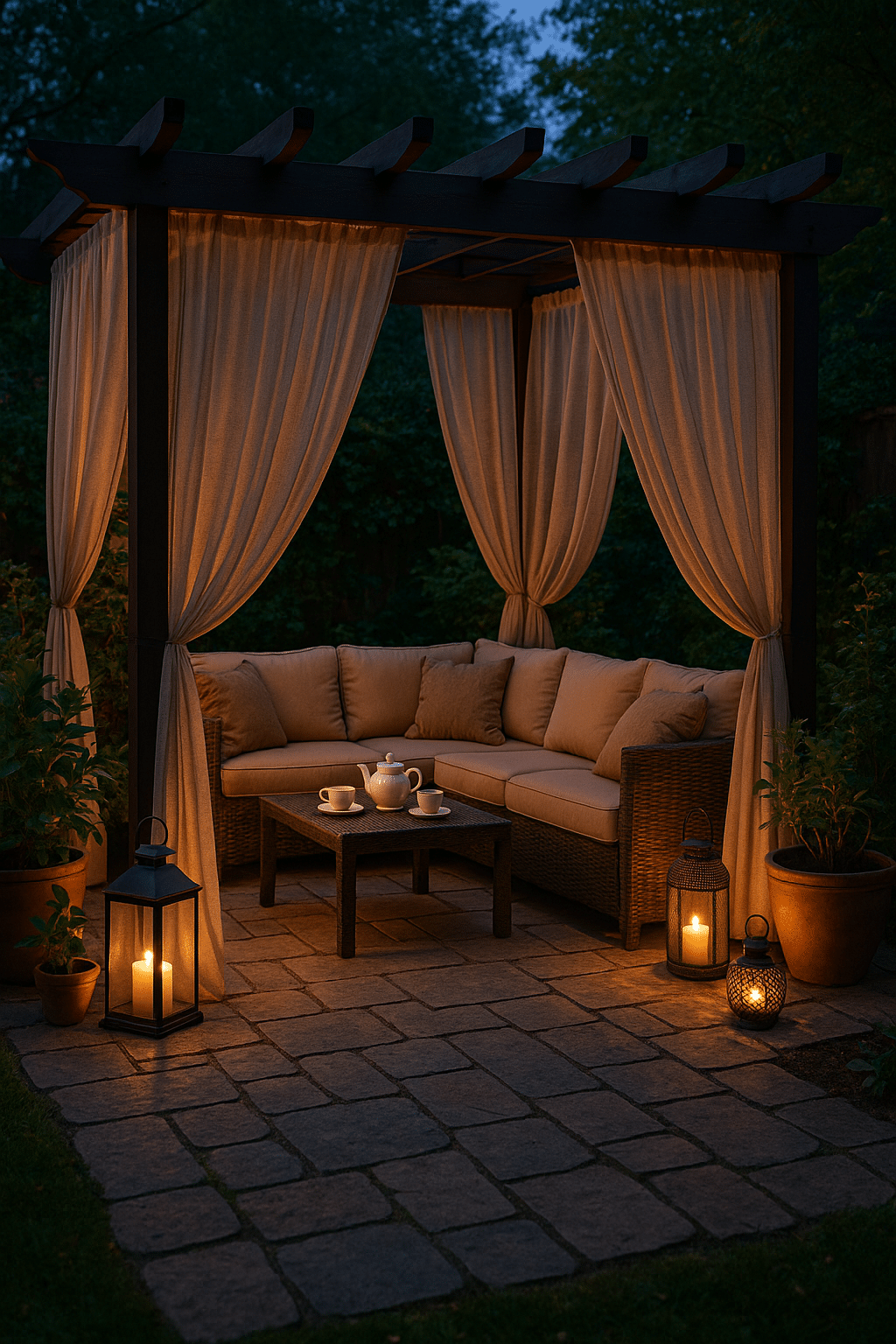
Privacy isn’t just about blocking sightlines — masking sound plays a key role in turning your backyard into a serene escape. Water features such as fountains and ponds provide natural white noise that drowns out unwanted noise pollution.
Choosing Fountains, Ponds, and Waterfalls for Noise Reduction
Among water features:
- Fountains: Especially tiered or bubblers, can be installed easily and add a soothing trickle sound.
- Ponds: Combined with small waterfalls, ponds create a gentle, continuous sound.
- Waterfalls: Even small cascading designs generate a pleasant rush that helps mask street or neighbor noise.
When selecting, consider size, water volume, and location to maximize sound diffusion toward the noise source. Placing water features near property borders or entryways often yields the best noise reduction.
Combining Water Features with Landscaping Design for Maximum Effect
Water features work best when incorporated thoughtfully into your landscaping. Surrounding a fountain with tall plants or sound-absorbing materials like mulch and gravel enhances both the acoustic effect and visual appeal.
For example, adding dense shrubs around a pond edge not only boosts privacy but also softens sound waves. Also, positioning seating areas near water creates a peaceful ambiance ideal for reading or entertaining.
Innovative Backyard Privacy Ideas without Traditional Fencing
Not all yards allow or desire classic fences. Fortunately, there are creative backyard privacy ideas without fencing that still keep your space secluded and stylish.
Natural Backyard Privacy Barriers Using Tall Planters and Shrubs
Tall planters filled with shrubs like boxwoods, holly, or ornamental grasses act as modular, movable privacy screens. These are perfect for patios or decks where permanent structures aren’t an option.
For instance, placing a row of tall planter boxes along a balcony edge creates a green barrier that’s easily rearranged seasonally. Mix evergreen and flowering shrubs for varied texture and color.
Creative Backyard Privacy Ideas for Small and Urban Yards
Urban environments demand smart solutions due to space constraints. Vertical gardens, hanging planters, and foldable screens are lifesavers here.
Smaller yards can benefit from:
- Compact bamboo privacy screens.
- Retractable fabric awnings combined with planter boxes.
- Multi-functional furniture doubles as privacy barriers.
Privacy Solutions Tailored for Renters and Pet Owners
Renters often face restrictions on permanent installations but still want privacy and functionality. Portable privacy screens, tension-mounted curtains, and large potted plants offer non-invasive options.
Pet owners also need durable materials that resist digging or scratching. Metal or composite screens with no gaps are ideal, while dense hedges provide natural shade and sound buffering for active animals.
Integrating Privacy with Outdoor Living Spaces and Sustainability
Blending privacy with functional outdoor living spaces demands careful design, especially if sustainability is a priority.
Sustainable Landscaping and Eco-Friendly Backyard Privacy Solutions
Incorporating compost, rainwater harvesting for irrigation, native plantings, and renewable materials like bamboo or reclaimed wood aligns with eco-friendly yard design.
Sustainable privacy screens using recycled pallets or solar-powered lighting can brighten pathways without drawing excess energy.
Balancing Privacy with Sun and Wind Protection in Design
Effective backyard privacy ideas often overlap with weather protection. Planting dense hedges on the windward side and installing pergolas or screens strategically shields seating areas from harsh sun and gusts without sacrificing fresh airflow.
By taking an integrated approach, you ensure your backyard is comfortable year-round, private, and visually appealing.
Conclusion: Blending Creativity, Practicality, and Privacy in Outdoor Spaces
Creating privacy in your backyard isn’t about erecting barriers alone; it’s about thoughtfully crafting an inviting haven tailored to your needs. By combining natural elements like tall hedges and native plants with functional structures—such as pergolas and vertical gardens—you can turn your outdoor space into a haven where peace, practicality, and beauty coexist.
Whether you have a sprawling yard or a compact city lot, there are backyard privacy ideas here that suit your lifestyle and budget. Remember, the best solutions often blend multiple strategies to balance seclusion with aesthetics, noise reduction, and sustainability.
I encourage you to assess your unique space, experiment boldly, and embrace both the artistic and practical sides of backyard design. Your ultimate goal? A backyard where you feel relaxed, shielded from prying eyes, and connected with nature. Dive in, and transform your outdoor living area into the private paradise you deserve.
FAQs on Backyard Privacy Ideas
1. What are the best backyard privacy ideas for small yards?
For small yards, vertical gardens, tall planters, and modern privacy screens work wonderfully. They maximize space by building upwards instead of outwards and can be combined with climbing vines or lightweight screens to create a cozy, private atmosphere without crowding your yard.
2. How can I create affordable backyard privacy solutions without breaking the bank?
DIY privacy screens using reclaimed wood, pallets, or inexpensive fabric curtains on pergolas offer budget-friendly privacy. Additionally, planting fast-growing hedge plants like Leyland Cypress or bamboo provides long-term privacy that’s cost-effective compared to permanent fencing.
3. Are there backyard privacy ideas effective at noise reduction?
Yes! Incorporating water features like fountains or waterfalls creates ambient white noise that masks surrounding sounds. Dense hedges of evergreen shrubs also absorb and block noise, especially when combined with layered landscaping that uses mulch, gravel, and natural barriers.
4. Can renters achieve backyard privacy without modifying the property permanently?
Absolutely. Renters can utilize portable privacy screens, outdoor curtains attached to freestanding pergolas, and tall potted plants. These solutions create flexible and non-invasive privacy that can be removed easily when moving.
5. What are eco-friendly backyard privacy solutions that also support sustainability?
Using native plants adapted to local climates, vertical gardens with efficient irrigation, compost-enriched soils, and recycled materials for screens or planters supports sustainability. Implementing rainwater harvesting and solar lighting further reduces your backyard’s environmental footprint while boosting privacy.
Quick Takeaways
- Tall hedge plants and native evergreens provide durable, year-round natural privacy.
- Pergolas combined with climbing vines and outdoor curtains offer stylish and customizable privacy solutions.
- Vertical gardens and living walls are ideal for small or urban yards to create green, eco-friendly screens.
- Modern and DIY privacy screens serve as functional art pieces that enhance backyard aesthetics.
- Water features provide soundproofing benefits, making outdoor spaces quieter and more serene.
- Alternative privacy options like tall planters and portable screens suit renters and pet owners.
- Integrating privacy with sustainable landscaping and weather protection promotes comfortable, eco-conscious outdoor living.
If you’re ready to make your backyard a private refuge while elevating its style and function, these ideas offer a perfect foundation. Take your time experimenting with plants, structures, and materials, and soon you’ll enjoy an outdoor space designed just for you.

